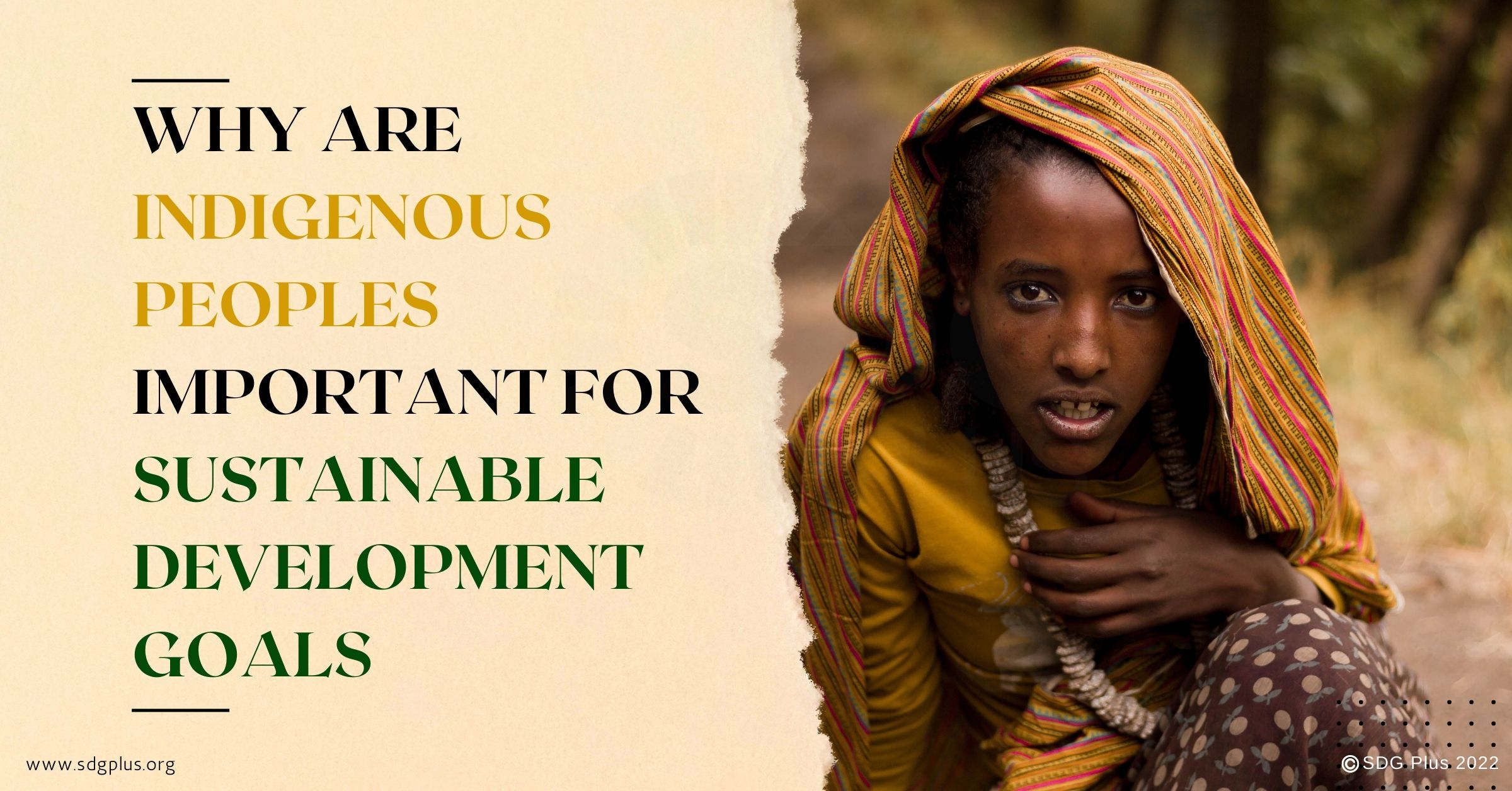
The Indigenous Future Becomes Everyone’s Future
Indigenous Peoples are the people of the land, just as we know them to be. To make it simpler, they have been the descendants of people who had inhabited a country or a geographical region during a period where people of different cultures and ethnicities existed.
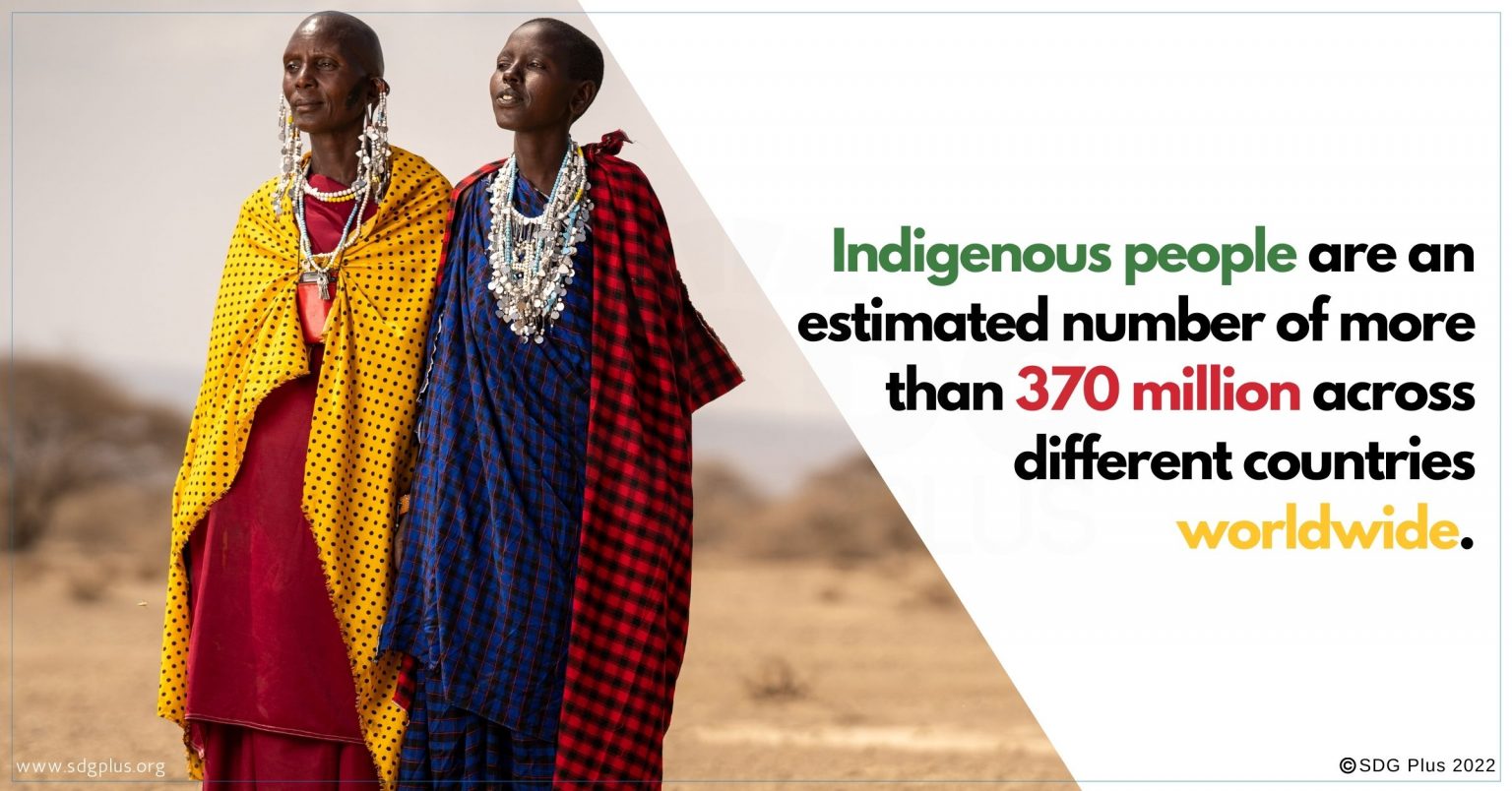
Natural resources and land, on which the Indigenous Peoples depend on, are linked to their livelihoods, cutlures, identities as well as their physical and spiritual well-being. Read more
Indigenous Peoples are crucial for the existence of the environment. They are necessary for sustainability to continue too. Before we explore that concept, let’s try to understand their relationship with nature a bit more.
What does ‘Indigenous’ as a term mean?
Indigenous’ as a term has been adopted over time. It is not a word that has been adopted universally by any institution, organization, or legal establishment.
In India, the Indigenous Peoples are also referred to as tribes. The Gonds, the Santhals, the Bodos, the Khasis and the Bhils are examples of Indigenous Peoples referred to as Tribes in India. There are a total of 645 tribes in India.
They are also known as Adivasis, aboriginals, the first peoples and janajatis. Other terms used to refer to them are based on their occupation such as nomads, peasants, and hunter-gatherers.
More often than not, the term ‘indigenous’ seem to hold negative connotations for people.
How so?
The Martinez Cobo Study of 1981
There has been a lot of thinking and debate over what the definition of ‘Indigenous Peoples’ should be.
The Special Rapporteur Jose R. Martinez Cobo has given a definition which is the most cited definition of Indigenous Peoples. He was the Special Rapporteur of the Sub-Commission on Prevention of Discrimination and Protection of Minorities, and the definition was provided in his infamous ‘Study on the Problem of Discrimination against Indigenous Populations’.
This study offered a working definition of Indigenous Peoples, Communities and Nations. Martinez expressed many ideas to provide an intellectual framework for Indigenous Peoples which led to including the right of the Indigenous Peoples to define who they are, by themselves.
The working definition provided by Martinez is as follows:
‘Indigenous communities, peoples and nations are those which, having a historical continuity with preinvasion and pre-colonial societies that developed on their territories, consider themselves distinct from other sectors of the societies now prevailing on those territories, or parts of them. They form at present non-dominant sectors of society and are determined to preserve, develop and transmit to future generations their ancestral territories, and their ethnic identity, as the basis of their continued existence as peoples, in accordance with their own cultural patterns, social institutions, and legal system.’
Do Indigenous Peoples in India experience any atrocities?
Yes, the Indigenous Peoples in India experience atrocities. According to the Crime Report 2016 of the National Crime Records Bureau of the Ministry of Interior, there are 6568 cases of crime. These are against the Indigenous Peoples. In 2015, 10.914 cases were reported.
They are affected by armed conflict, sometimes caught between security forces and armed security groups. Some of these cases are not reported.
The right to their land, the safety and security of the women and girls from their communities are overlooked. Issues of trafficking, displacement induced by development, violation of individual and collective rights and branding are rampant. Read more
The Holders of Knowledge
Indigenous Peoples have languages that cannot be translated even today as they have no script. Their languages are unique, just like their culture and practices. They possess invaluable knowledge on sustainable practices and have been passing it down through generations. The land that they live on is ancestral. It holds a special place of importance to them. All their practices are based on traditional knowledge, values, priorities and needs that are to be met without causing damage and destruction to nature.
Their ultimate resolve is to maintain the ancestral environment and reproduce the very same
environment for years to come.
Urbanization is a concept that may not agree with their practices.
Governments and individuals have a lot to learn from these communities. Indigenous Peoples set examples for sustainable practices. How have they managed to do that? Their lifestyle depends entirely on the harmonious relationship they share with nature. If they continued just like we did, climate change, loss of biodiversity and the increase of pollution would be accelerated. The Indigenous Peoples have maintained a balance for the damage that has been done by urbanization. To state a known example, The Amazon Forest Fires.
The forest fires destroyed vegetation, species and lives of the Indigenous Peoples who lived there. The forest fires affected both humanity and nature. The key understanding here is that the forest fires not only affected the Indigenous Peoples, but also contributed negatively towards pollution and environmental degradation.
In particular, the Awa people living on the Bananal Island in the Tocantins State, the uncontacted Awá inhabiting the Arariboia Indigenous Reserve in Maranhão state; and uncontacted groups in the Uru Eu Wau Wau Indigenous territory in Rondônia and Ituna Itatá Indigenous territory in Pará, the Brazilian state with the highest deforestation and land conflicts rates, were the ones to be severely affected by the Amazon Forest fires of 2020. It is unfortunate that the existence of the estimated hundred plus Indigenous Groups, that are isolated and are living within the forest borders, is threatened by The Amazon Forest fires have threatened their existence. Read more
The Uncontacted Indigenous Peoples are the most vulnerable groups to deforestation and forest fires, because they rely completely on the forests for food, shelter and medicine. Destruction of forests also causes them to move away from their original territories, leading them to encounter outsiders.
Considering the little immunity that they have, this could lead to exposure to diseases.
Incidents like these have led to deaths of communities entirely. And now, with particular reference to COVID-19, more than 1,57,000 Brazilians are dead (which includes Indigenous Peoples as well). Read more
The decline of nature is unprecedented, and it is happening at a faster pace than calculated. According to a report in 2019 by the United Nations-backed Intergovernmental Science-Policy Platform on Biodiversity and Ecosystem Services (IPBES), the world is declining at a faster pace than at any point in human history.
The health of the ecosystems and the species is deteriorating rapidly. It is delicate because the foundation of our economy, technology and social paradigms is dependent on the health and existence of
the ecosystem. The Report had found that around 1 million animal and plant species were now threatened with extinction, many within decades, more than ever before in human history. Read more
For the Indigenous Communities, the rate of deterioration and decline has been less severe in comparison to other communities experiencing it in general.
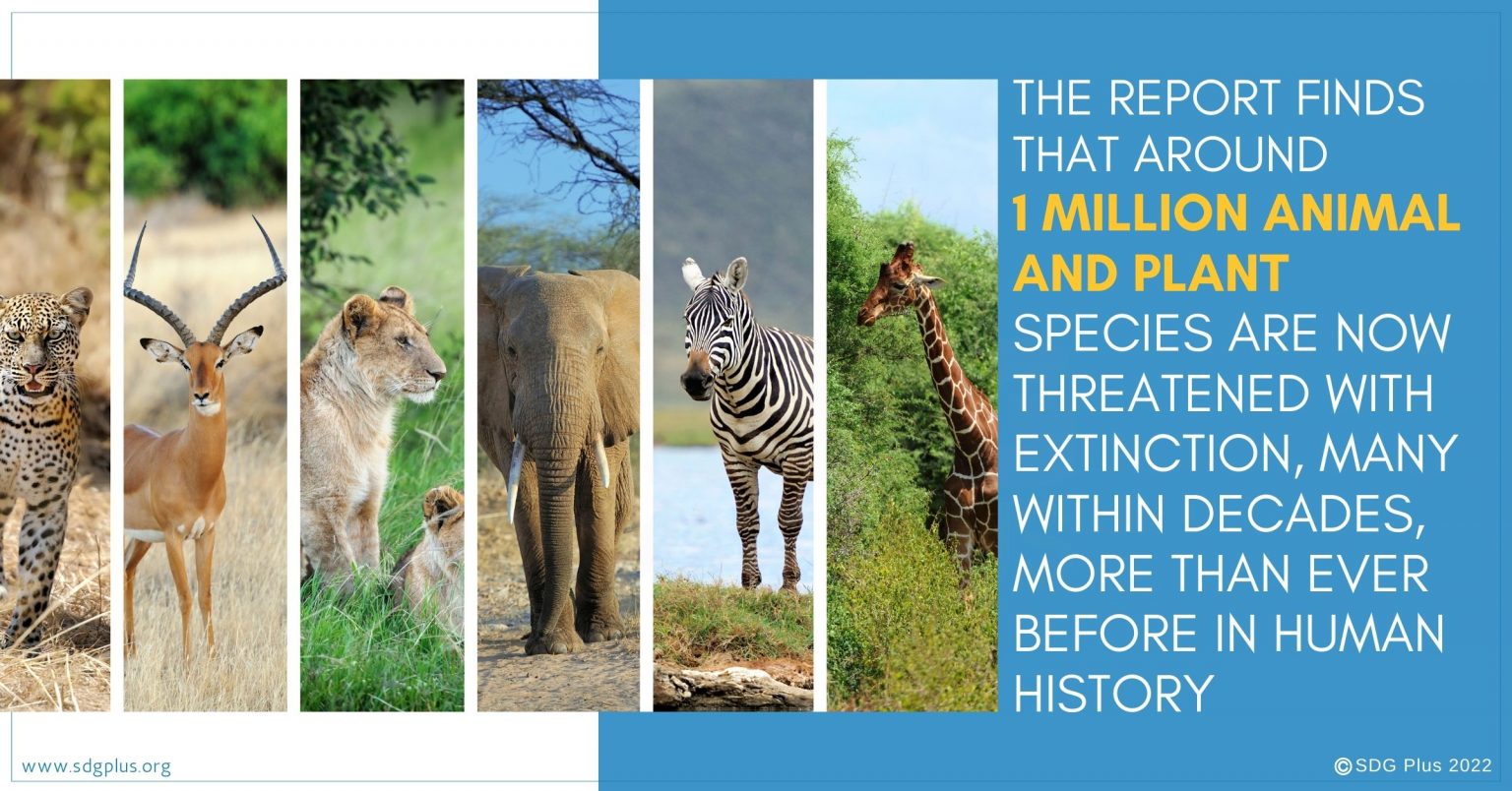
Why is it so?
The traditional knowledge and the traditional practices by the Indigenous Communities have amalgamated practical methods of balancing the use of natural resources such as water, fertile soil, food, and medicines without compromising it for the future.
Siham Drissi, the Biodiversity and Land Management Programme Officer with the United Nations Environment Programme said, ‘Biodiversity loss and climate change, in combination with the unsustainable management of resources, is pushing natural spaces around the world, from forests to rivers to savannahs, to their breaking point. We absolutely need to protect, preserve, and promote the traditional knowledge, customary sustainable practices and expertise of indigenous communities if we want to halt the damage we are doing- and ultimately save ourselves.’
How are the Indigenous Peoples helping the world achieve Zero Hunger?
Zero Hunger is the 2nd Sustainable Development Goal. The recent update on SDGs indicates that the world is not on the right track to achieve SGD 2: Zero Hunger by 2030. If this continues to grow, the estimated number of people to go hungry will surpass 840 million by 2030. A substantial change in the global agricultural system is needed if the 690 million hungry people are to be nourished healthily today. Agricultural productivity must increase. A sustainable method to cultivate and produce food is necessary
to help achieve this goal.
The Indigenous Peoples constitute only 5 percent of the global population. They are key to the survival of the environment. 22 percent of the world’s land surface is encompassed by traditional indigenous territories.
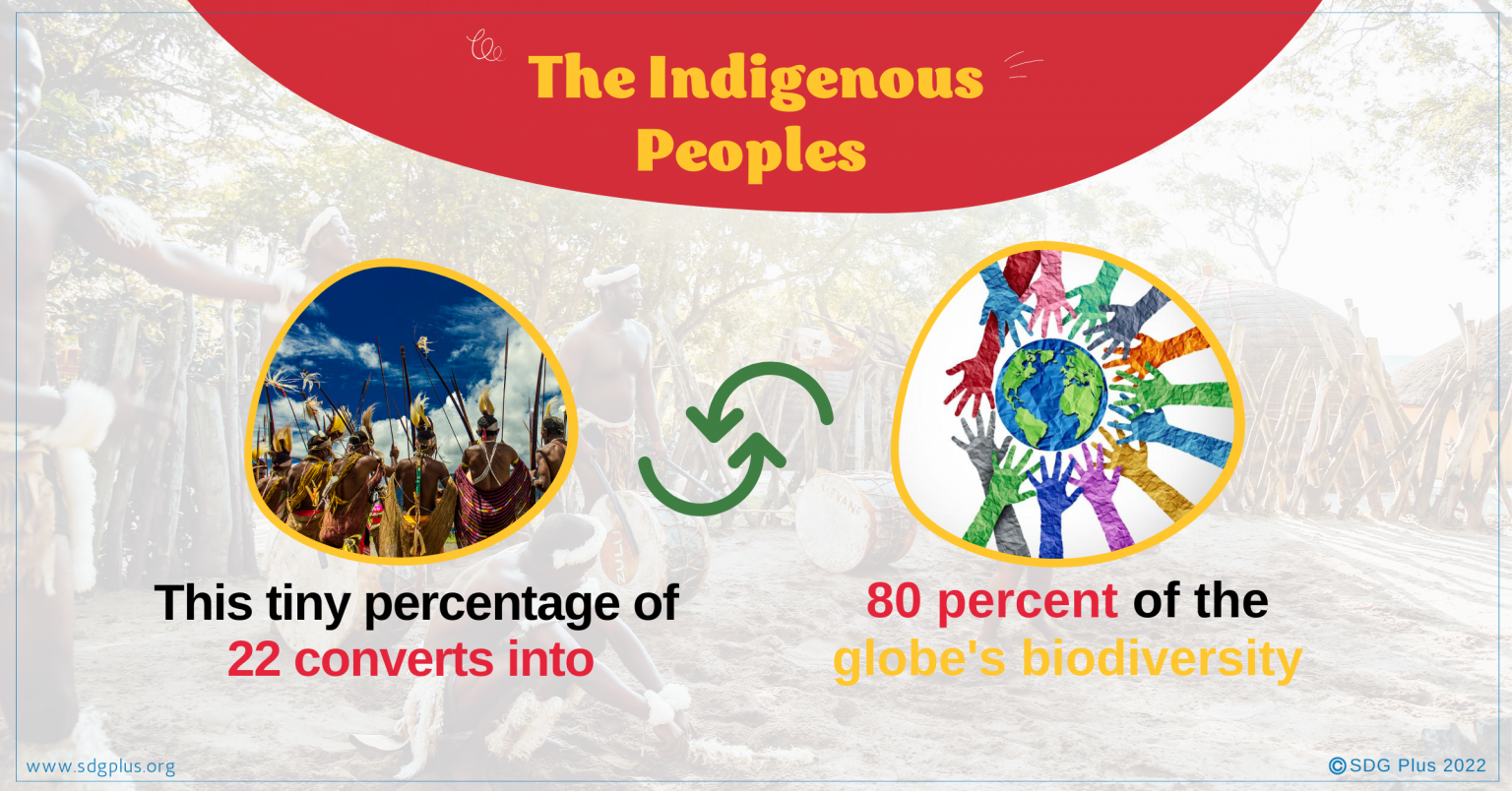
The Indigenous Peoples have been managing forests (which are vital to curb greenhouse gas emissions) from before we moved to larger civilizations. Their food is nutritious, resilient to climate and adapts to the environment. Their way of life teaches us a lot regarding preservation of natural resources, cultivating and producing food in sustainable ways; all of which are in harmony with nature. Using their knowledge and implementing their methods will help address climate change, hunger problems, and make agriculture sustainable.
Let us explore further
1. Conservation
The Indigenous Peoples are connected to the environment. The environment is part of the life they live, and the ecosystem they live in. The environment is not seen as an isolated element. It is a part of who they are. Natural resources such as forests and rivers are considered as part of their own, so they conserve and protect the resources. This helps in addressing hunger (resources grow in their natural time and replenish in a sustainable manner, which provides food for every member of the community).
2. Traditional practices and Climate Change
Their cultural practices have adapted for different climatic regions. From the Andes to Kenyan grasslands and the extreme cold weathers of northern Canada, the Indigenous Peoples have a terrace farming method that stops soil erosion. They also develop floating farms which use flooded fields. The floating farms are built in the wetlands, submerged areas or flooded areas in Paroipur district, Barisal district and Gopalganj district of Bangladesh. These fields remain flooded for a long duration, especially during the
monsoon season.
Their agricultural or farming methods are suited for all types of climatic conditions, which guarantees food availability for everyone. It helps mitigate hunger problems.
To know more about the detailed process of preparing a floating farm, read more
3. Diversification of diet
The Indigenous Peoples cultivate moringa, oca and quinoa which are classified as native crops. Moringa is native to different parts of Asia and Africa. They are nutritious. This will help expand the food base of people in general because we rely on regular staple crops such as rice, wheat, barley, potatoes, and maize. Diversification of diet takes place because not only do they use regular staples, but they also use native crops and plants for fodder.
4. Adaptable food
The Indigenous Peoples’ food has been grown in different climatic conditions, which makes them cultivable in various parts of the globe. They are drought-resistant, flood-resistant, and resilient to other weather conditions. If such methods and crops can be popularized for cultivation in other parts of the world, access to nutritional food will be less of an issue and can help mitigate hunger, bringing an additional contribution towards zero hunger.
5. Crucial Biodiversity
The Indigenous Peoples not only preserve the environment but are responsible for holding 80 percent of the world’s biodiversity. The genetic pool of plant and animal species is immense, rich and is found in the rivers and pastures of their ecosystems. Protecting and preserving their genetic pool of plants and
animals will help in contributing towards zero hunger.

6. Indigenous Lifestyle
Their lifestyles are already inclusive of sustainable practices and respect for the environment. Preservation of soil, reduction of soil erosion and conservation of water are daily practices. If these practices are adopted by people across the globe, it will bring a change. Not only will climate change be mitigated, the Sustainable Development Goal of achieving Zero Hunger will also be more
attainable. Read more
What do Indigenous Peoples of India eat?
India is home to 705 Indigenous Communities. The edible greens they produce and consume are marine algae, stems, shoots and leaves. Root vegetables are tubers, rhizomes, bulbs and corms. Fleshy fruits are berries, drupes and pomes. Grains, nuts, seeds, edible wild mushrooms, edible shrubs and herbs, and wild harvested insects, fish and game (meat).
To know more about their food, read more
Indigenous Peoples in India and how they are conserving biodiversity:
India is home to immense biodiversity. There are 45,000 species of wild plans. Out of these 9,500 species are important species ethnobotanically. Again, out of these, 7,500 species are known for medicinal use for indigenous health practices. Around 3,900 plant species are used as food by tribals, which comprise of tubers,
roots, leafy vegetables, flowers, bulbs and fruits. Further, 525 species are utilized for fiber, 400 for fodder, 300 for preparing and extracting chemicals that naturally occur as insecticides and pesticides.
(Citation: Push pagandhan P. (1994) Ethnobiology in India. A status report, Ministry of Enviroment and Forest,
GOI,New Delhi)
What is their role in conserving biodiversity then?
Many of their plants are conserved in a natural habitat becase of the concept ‘magico’, which is a religious belief that it is the habitat of their god and goddess. This is prevalent in Dindori, Balaghat and Mandala districts of Madhya Pradesh. It is also seen in Kawardha and Bilaspur districts of Chhattisgarh. Here, tribals worhsip flowers and trees because they believe that their gods reside in these flowers and trees. Here’s a list of the plants that they conserve:
Why do they conserve biodiversity?
- Plants and flowers are worshipped as part of their religious belief
- They are also part of their food
- Plants conserved in their natural forest habitat are used as antidotes for snake bites and scorpion stings. For example, rhizomes of plants such as Acorus calamus, stem bark of Bunchania lanzan, stem and leaves of Moringa oleifera, Achyrnthus aspera, Gynandropsis gynandra, Bombax ceiba are beingused as antidotes.
- They are conserved to be used for medicinal purposes. For example, Plants like Equisetum ramosissimum, Argemone maxicana are dried, powdered and paste is applied on infested portion of skin and on wounds. Plants like Bauhinia purpurea, Sida acuta, Jatropha curcus, Grewia hirsutum,
Albizzia lebbeck, Capparis deciduas are conserved as used in muscular pain, cure of fever, headcache, and body swelling. - Plants are conserved in sacred groves of tribals, similar to the concept of in-situ conservation. These sacred groves are the natural forests located inlocated in North – East, Central and Peninsular India.
Why are Sustainable Development Goals important for Indigenous Peoples?
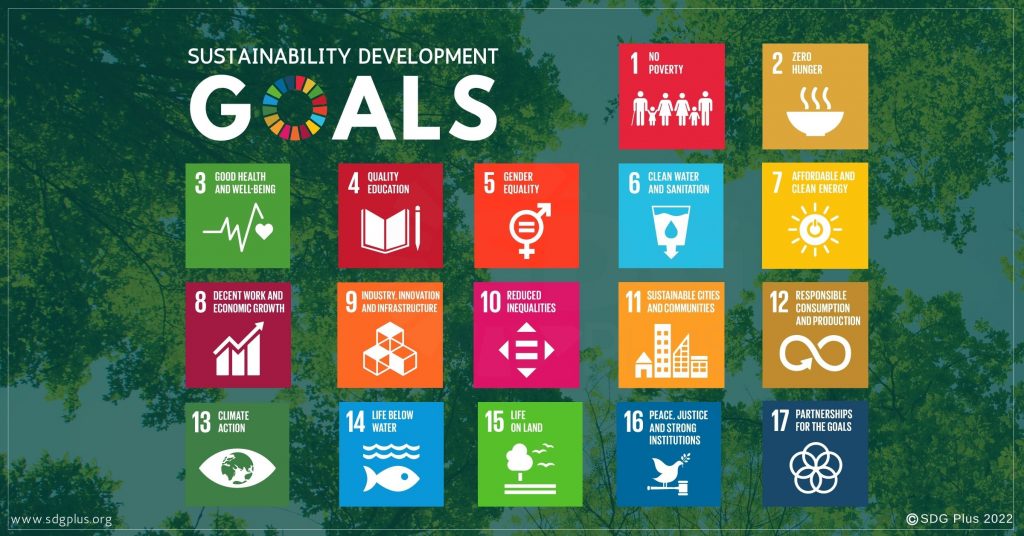
With the goal of ‘No one should be left behind’, the SDGs are equally important for the Indigenous Peoples. Within their communities, there is inequality. Women face the necessity for empowerment. Economic growth, poverty and even disability are issues that the Indigenous Peoples are experiencing. Some of them need legal representation to be heard. Read more
Many communities experience malnourishment, which affects their good health and well-being. Although they have a sustainable lifestyle, their physical, emotional, spiritual and mental well-being have to be addressed.
They experience pressure to protect and preserve the environment, yet they are discriminated against due to the culture and the community they belong to.
The concept of sustainability, and the Sustainable Development Goals are important for the Indigenous Peoples. Being ‘guardians’ of nature, they need assistance; they need to be heard. Read more
17 Goals and Indigenous Peoples
Goal 1: No Poverty
Poverty amongst the Indigenous Peoples is a big challenge. Due to their economic, social and climaterelated vulnerabilities, the Indigenous Peoples are experiencing a lack of protection and guarantee for the future. With no access to social protection systems, they account for 15 percent of the world’s poor in demography.
Goal 2: Zero Hunger
The Indigenous Peoples have been facing threats to their ecosystem and traditional practices ofagriculture, nutrition, cultivation, food habits and food gathering. Each community in different parts of the globe have different methods that they practice. The loss of access to natural resources and land, with the impact of climate change on their daily lives and activities has led to insecurity with food, leading to hunger and malnutrition.
Goal 3: Good Health and Wellbeing
The Indigenous Community experiences a lack of good health and wellbeing. Their life expectancy is considered to be 20 years lower than non-indigenous peoples. Their illness revolves around diseases such as tuberculosis, HIV, AIDS and malaria.
Goal 4: Quality Education
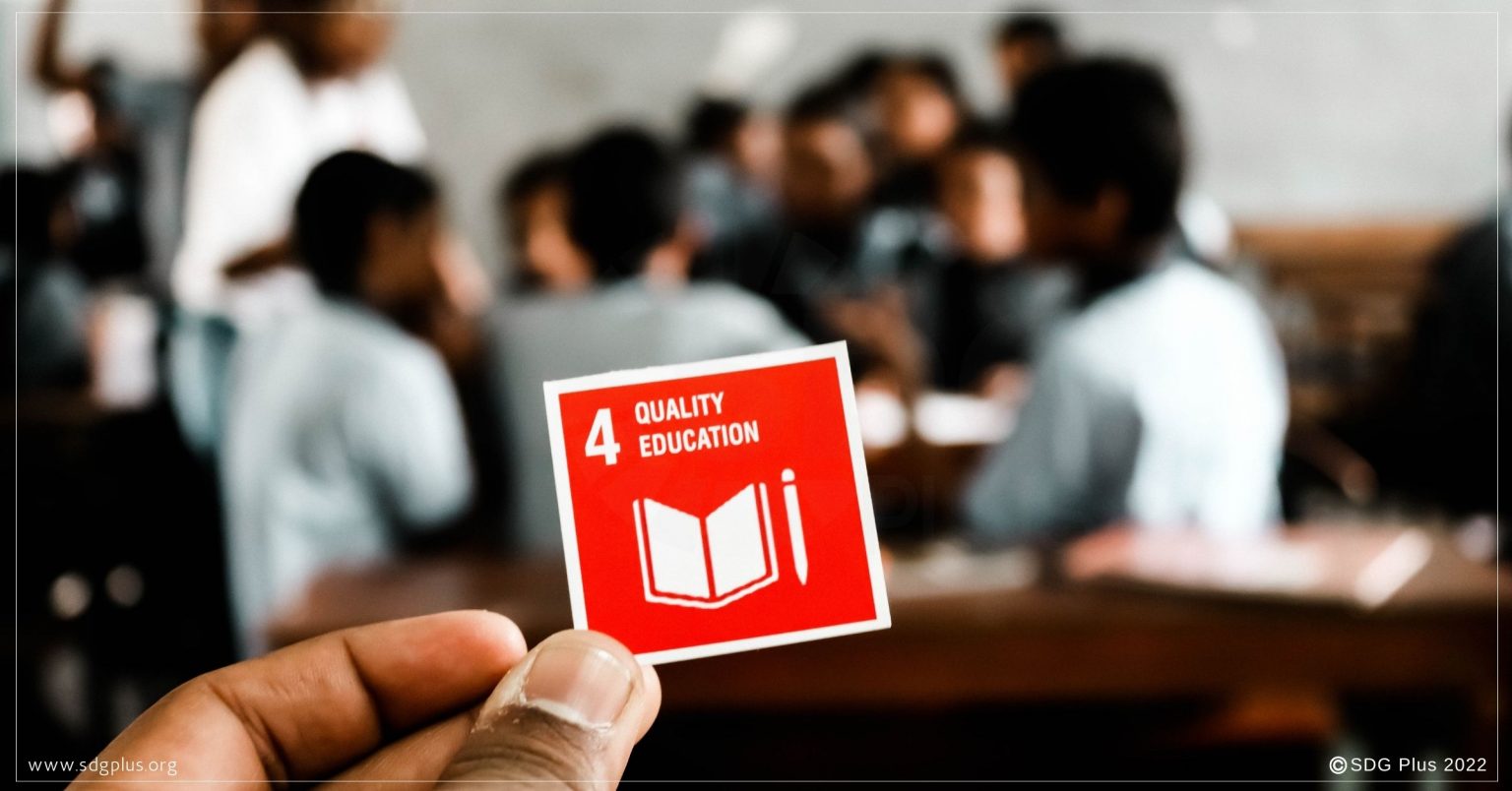
Indigenous Peoples experience a huge gap when it comes to quality education. Yes, they pass on the traditional form of knowledge and practices, but when it comes to formal education, they do not have access to it. They do not have access to trending opportunities across the globe. Communication also
gets in the way because their languages cannot be deciphered or translated for non-Indigenous Peoples
to comprehend.
Goal 5: Gender Equality
When it comes to decision making, role identification between men and women and socio-economic barriers faced, women do not have equality in the Indigenous community. Discrimination exists both within the Indigenous Communities, and from non-Indigenous Communities as well. Many of the Indigenous Peoples have been actively looking for and participating in domestic work to generate sources of income.
Goal 6: Clean Water and Sanitation
Living in the natural ecosystem, their natural resources are contaminated due to urbanization and are further threatened by climate change. This takes away their access to naturally clean water and further affects their health and wellbeing. Finding clean water becomes a major challenge, especially for women who have to search for it.
Goal 7: Affordable Clean Energy
Indigenous Peoples do not have access to renewable, affordable, or clean energy. This could have an impact on their agricultural practices. Here is a twist to the story. Fossil fuel projects run by large international companies, including projects for renewable and clean energy have negative impacts on their community. It leads to instances where communities are forced to alienate or leave that land
because the natural resources are contaminated due to these projects.
Even instances of mining, extraction of coal and dam construction have negative impacts on the community, thereby impacting their ability to have clean energy since their economic livelihood is impacted by such activities.
Goal 8: Decent Work and Economic Growth
The Indigenous Community has faced plenty of discrimination and ill-treatment for who they are, and the livelihoods they have. They have been forced to cope with such challenges for all kinds of opportunities. Climate change, environmental degradation and rapid globalization has threatened their lives, which already is threatened. The younger generations of Indigenous Communities across the globe have to benefit from changing trends in economic cultures, economic opportunities, and skilled workforces.
The Indigenous Communities have to be able develop new skills for new jobs, quality education for a quality life which combines their cultural and traditional practices. Unemployment is a phenomenon they experience in commonality. Many women and girls work in informal sectors with jobs in agriculture and domestic labour. Many of them also are trafficked and this does not bode well for safety considering the problems they already face.
Keeping all this in mind, their traditional knowledge is valuable for economic growth, and it will help build a decent teaching work force for generations to come. A way has to be found where their knowledge and practices can be brought to the mainstream for non-Indigenous Communities to know and practice as well.
Goal 9: Industry, Innovation, and Infrastructure
Since they live in forest ecosystems and are one with nature, the Indigenous Communities have not focused on concepts of industrialization and concrete infrastructure. This leads to the Indigenous Peoples missing out on opportunity for work and being able to realize their full potential for work.
If they are unable to realize their full potential due to lack of opportunities, they will not be able to push the limits of their traditional knowledge to help save the environment.
Goal 10: Reduced Inequalities
With non-recognition of their rights, the Indigenous Peoples are limited by many constraints including their economic status and discrimination over origin, that prevents them from achieving any kind of equality. Social protection policies do not provide coverage for Indigenous Peoples, especially for the women. Inequalities in all spheres, from culture and social to economic and educational spheres, they have been held back by lack of recognition, lack of validation and lack of acceptance. At the same time, they have not been consulted with for their knowledge on traditional practices. Their information has to be put to the forefront in order to bring about recognition and tackle inequality. This will also help reduce lack of access to non-Indigenous activities.
Goal 11: Sustainable Cities and Communities
Within their own communities, the Indigenous Peoples practice sustainability but have been reduced to inequality in all spheres of life. To help with their livelihood, they migrate to urban cities in search of employment opportunities. Depending on the jobs they find, their lifestyle and wellbeing is tied to it.
Being unable to adapt to the urban practices of life, the discrimination and exclusion from society makes it difficult for them to continue. How do they remain a sustainable community then? How do Indigenous Peoples continue to practice sustainability if they are reduced to such problems in the name of employment and livelihood?
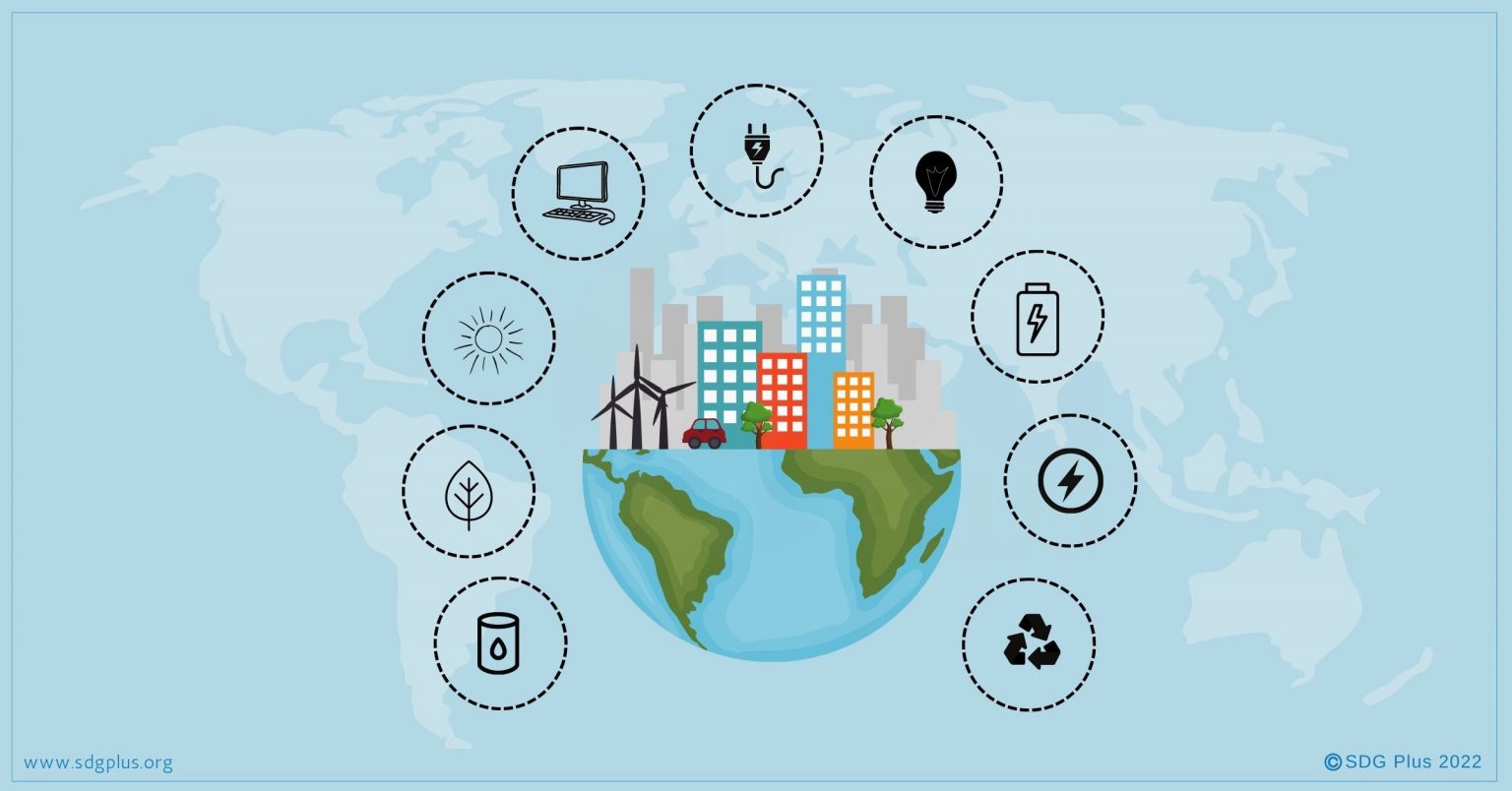
Goal 12: Responsible Consumption and Production
Think about it. We ourselves do not have habits of consuming responsibly. How often have we actually eaten all the food on the table? How often have we consumed all the boring salad that is nutritious for our bodies? Not much, right?
Well, our practices affect the Indigenous Peoples. We eat too much and take too much from the environment. This adds a severe amount of pressure on the environment to not only reproduce, but also to also replenish enough for everyone. And who are the ones guarding nature? Who lives as one with
the environment? The Indigenous Peoples.
Goal 13: Climate Action
From what we read so far, it is clear that the Indigenous Peoples are one with nature. So what stops us from thinking that they will be the first ones to experience the repercussions of climate change? It is going on for many years now. The Indigenous Peoples are at the forefront of every climatic setback that takes place. And mind you, the Amazon Forest Fires is not the first one to begin with. Already having to suffer from economic limitations to cultural differences, the Indigenous Peoples are forced to face more with climate change and Mother Nature fighting back against pollution and all the problems created by mankind.
Goal 14: Life Below Water
The Indigenous Communities that live on coastlines and close to water bodies are again under threat of food and water scarcity. Over-exploitation of marine resources will lead to lack of resources for the Indigenous Communities. It is important to note that Life Below Water forms an important aspect for them. They already do not have access to clean drinking water. If the existing water bodies are contaminated, their daily life is affected.
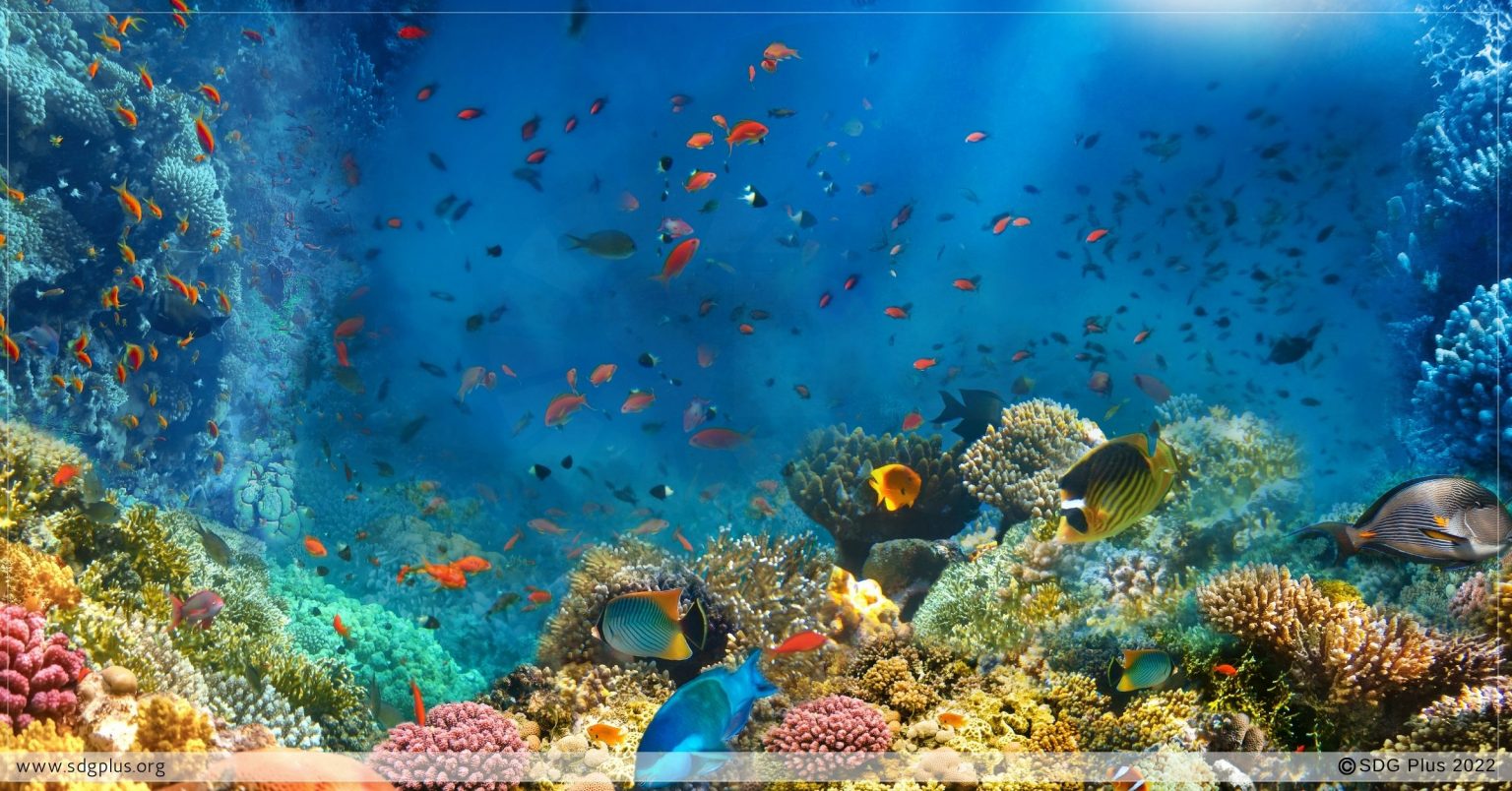
Goal 15: Life on Land
Yes, now we know who they are and what they do. Why is Life on Land important for them then? Just like they need water bodies, most of the Indigenous Peoples live on land. Forests and soil are natural components of their daily life. How important is their life on land? Most of the important resources come from the forests. Climate change, pollution, deforestation, desertification of forest land- all of them impact the daily livelihood of the Indigenous Peoples. Conservation policies for the land they live in are either poor, or not covered at all. What will they do?
Goal 16: Peace, Justice and Strong Institutions
There are not enough institutions that speak for or represent the Indigenous Peoples. Discriminatory laws and policies have kept them away from mainstream recognition and hearing. This goal is key to their community because it will bring about validation and recognition, and it will also lead to bringing forth the knowledge that they carry for sustainable and nature-friendly practices.
Goal 17: Partnership for the Goals
The Indigenous Peoples are crucial for the success of the Sustainable Development Goals. They are at the crux of sustainability. With their work and knowledge, we can make further attempts to mitigate climate change. They can be partnered and networked with, to bring awareness not only about their community but their life as a whole; which will benefit even the non-Indigenous Peoples in the long run.
The Indigenous Peoples are important to the realization of the Sustainable Development Goals. They are connected to all 17 Goals and equally affected by the setbacks of the SDGs. At the center of all this is climate change which affects them very deeply. Their life and existence is threatened with climate
change and environmental degradation.
Think about it this way:
Some of us are non-Indigenous Peoples. We live our lives unaffected, unbothered by crucial aspects which have long-term effects. Even while using jute bags for groceries, we do not really worry about how useful that is for the environment. It is probably a trend, a fad. That is why some attempt it.
But it helps such people in different parts of the world. Small sustainable practices go a long way in making sure someone else has an apple tree to get food from.
Weird, isn’t it? How all of our small actions are interconnected with people and lives we are not even connected to? Being mindful of our actions and their repercussions on the world is now the best path forward.
That is sustainability. That is a sustainable practice. And that is the future